The Regional Efficiency in the Use of European Agricultural Funds in Spain: Growth and Employment Analyses
Abstract
1. Introduction
- Less developed regions: those whose gross domestic product (GDP) per capita is less than 75% of the average GDP of the EU-27.
- Regions in transition: those whose GDP per capita is between 75% and 90% of the average GDP of the EU-27.
- More developed regions: those whose GDP per capita is above 90% of the average GDP of the EU-27.
2. The Agricultural Funds
2.1. The European Agricultural Fund for Rural Development
2.2. The European Agricultural Guarantee Fund
3. Methodology
4. Results
5. Discussion and Conclusions
Author Contributions
Funding
Institutional Review Board Statement
Informed Consent Statement
Conflicts of Interest
References
- Fennell, R. The Common Agricultural Policy: Continuity and Change; Clarendon Press, Oxford University Press: Oxford, NY, USA, 1997. [Google Scholar]
- Zobbe, H. The Economic and Historical Foundation of the Common Agricultural Policy in Europe; Institute of Food Economics, Unit of Economics, Royal Veterinary and Agricultural University: Frederiksberg, Denmark, 2001; pp. 1–20. [Google Scholar]
- Saunders, C. EU Agenda: Reforming the CAP: A new agenda. N.Z. Int. Rev. 2000, 25, 24. [Google Scholar]
- Cunha, A.; Swinbank, A. An Inside View of the CAP Reform Process; Oxford University Press: Oxford, NY, USA, 2011. [Google Scholar]
- Matthews, A. Greening Agricultural Payments in the EU’s Common Agricultural Policy. Bio-Based Appl. Econ. 2013, 2, 1–27. [Google Scholar]
- Leco, F.; Pérez, A. Desajustes territoriales en la distribución del Pago Básico de la PAC en España. Cuad. Geográficos 2019, 58, 57–82. [Google Scholar] [CrossRef]
- Bravo-Ureta, B.E.; Pinheiro, A.E. Efficiency Analysis of Developing Country Agriculture: A Review of the Frontier Function Literature. Agric. Resour. Econ. Rev. 1993, 22, 88–101. [Google Scholar] [CrossRef]
- Chavas, J.P.; Aliber, M. An analysis of economic efficiency in agriculture: A nonparametric approach. J. Agric. Resour. Econ. 1993, 18, 16. [Google Scholar]
- Thiam, A.; Bravo-Ureta, B.E.; Rivas, T.E. Technical Efficiency in Developing Country Agriculture: A Meta-Analysis. Agric. Econ. 2001, 25, 235–243. [Google Scholar] [CrossRef]
- Malá, Z. Efficiency analysis of Czech organic agriculture. E M Ekon. Manag. 2011, 1, 14–28. [Google Scholar]
- Ndlovu, P.V.; Mazvimavi, K.; An, H.; Murendo, C. Productivity and Efficiency Analysis of Maize under Conservation Agriculture in Zimbabwe. Agric. Syst. 2014, 124, 21–31. [Google Scholar] [CrossRef]
- Reith, C.C.; Guidry, M.J. Eco-Efficiency Analysis of an Agricultural Research Complex. J. Environ. Manage. 2003, 68, 219–229. [Google Scholar] [CrossRef]
- Clark, M.; Tilman, D. Comparative analysis of environmental impacts of agricultural production systems, agricultural input efficiency, and food choice. Environ. Res. Lett. 2017, 12, 064016. [Google Scholar] [CrossRef]
- Velasco-Muñoz, J.F.; Aznar-Sánchez, J.A.; Belmonte-Ureña, L.J.; López-Serrano, M.J. Advances in water use efficiency in agriculture: A bibliometric analysis. Water 2018, 10, 377. [Google Scholar] [CrossRef]
- Mathijs, E.; Swinnen, J.F. Production organization and efficiency during transition: An empirical analysis of East German agriculture. Rev. Econ. Stat. 2001, 83, 100–107. [Google Scholar] [CrossRef]
- Sanneh, N.; Moffitt, L.J.; Lass, D.A. Stochastic efficiency analysis of community-supported agriculture core management options. J. Agric. Resour. Econ. 2001, 26, 417–430. [Google Scholar]
- Béraud, A. Jules Dupuit (1804–1866). In Handbook on the History of Economic Analysis Volume I; Faccarello, G., Kurz, H.D., Eds.; Chapter 28; Edward Elgar Publishing: Cheltenham, UK, 2016. [Google Scholar] [CrossRef]
- Farrell, M.J. Measuring the Technical Efficiency. J. R. Stat. Soc. 1957, 120, 253–290. [Google Scholar]
- Buchelli, G.A.; Marín Restrepo, J.J. Estimación de la eficiencia del sectormetalmecánico en colombia: Análisis de la frontera estocástica. Cuad. Econ. 2012, 31, 257–286. [Google Scholar]
- Emrouznejad, A.; Yang, G.L. A survey and analysis of the first 40 years of scholarly literature in DEA: 1978–2016. Socio-Econ. Plan. Sci. 2018, 61, 4–8. [Google Scholar] [CrossRef]
- Karimov, A. Productive Efficiency of Potato and Melon Growing Farms in Uzbekistan: A Two Stage Double Bootstrap Data Envelopment Analysis. Agriculture 2013, 3, 503–515. [Google Scholar] [CrossRef]
- Niavis, S.; Tamvakis, N.; Manos, B.; Vlontzos, G. Assessing and Explaining the Efficiency of Extensive Olive Oil Farmers: The Case of Pelion Peninsula in Greece. Agriculture 2018, 8, 25. [Google Scholar] [CrossRef]
- Jalilov, S.M.; Mainuddin, M.; Maniruzzaman, M.; Alam, M.; Islam, T.; Jahangir Kabir, M. Efficiency in the Rice Farming: Evidence from Northwest Bangladesh. Agriculture 2019, 9, 245. [Google Scholar] [CrossRef]
- Arru, B.; Furesi, R.; Madau, F.; Pulina, P. Recreational Services Provision and Farm Diversification: A Technical Efficiency Analysis on Italian Agritourism. Agriculture 2019, 9, 42. [Google Scholar] [CrossRef]
- Sintori, A.; Liontakis, A.; Tzouramani, I. Assessing the Environmental Efficiency of Greek Dairy Sheep Farms: GHG Emissions and Mitigation Potential. Agriculture 2019, 9, 28. [Google Scholar] [CrossRef]
- Mengui, K.C.; Oh, S.; Lee, S.H. The Technical Efficiency of Smallholder Irish Potato Producers in Santa Subdivision, Cameroon. Agriculture 2019, 9, 259. [Google Scholar] [CrossRef]
- Havlíček, J.; Dömeová, L.; Smutka, L.; Řezbová, H.; Severová, L.; Šubrt, T.; Šrédl, K.; Svoboda, R. Efficiency of Pig Production in the Czech Republic and in an International Context. Agriculture 2020, 10, 597. [Google Scholar] [CrossRef]
- Gołaś, M.; Sulewski, P.; Wąs, A.; Kłoczko-Gajewska, A.; Pogodzińska, K. On the Way to Sustainable Agriculture—Eco-Efficiency of Polish Commercial Farms. Agriculture 2020, 10, 438. [Google Scholar] [CrossRef]
- Fernández-Uclés, D.; Elfkih, S.; Mozas-Moral, A.; Bernal-Jurado, E.; Medina-Viruel, M.J.; Abdallah, S.B. Economic Efficiency in the Tunisian Olive Oil Sector. Agriculture 2020, 10, 391. [Google Scholar] [CrossRef]
- Işgın, T.; Özel, R.; Bilgiç, A.; Florkowski, W.J.; Sevinç, M.R. DEA Performance Measurements in Cotton Production of Harran Plain, Turkey: A Single and Double Bootstrap Truncated Regression Approaches. Agriculture 2020, 10, 108. [Google Scholar] [CrossRef]
- Bahta, Y.T.; Jordaan, H.; Sabastain, G. Agricultural Management Practices and Factors Affecting Technical Efficiency in Zimbabwe Maize Farming. Agriculture 2020, 10, 78. [Google Scholar] [CrossRef]
- Quesada, V.M.; Blanco, I.D.C.; Maza, F.J. Análisis envolvente de datos aplicado a la cobertura educativa en el departamento de Bolívar-Colombia (2007–2008). Omnia 2010, 16, 77–100. [Google Scholar]
- Martič, M.M.; Novakovič, M.S.; Baggia, A. Data envelopment analysis-basic models and their utilization. Organizacija 2009, 42, 37–43. [Google Scholar]
- Worthington, A.; Dollery, B. Un estudio empírico de las técnicas de medición de la eficiencia de frontera en el gobierno local. Estud. Gob. Local 2000, 26, 23–52. [Google Scholar] [CrossRef]
- Zhonghua, C.; Ye, W. Fronteras de investigación en la medición del desempeño del sector público. Proced. Física 2012, 25, 793–799. [Google Scholar]
- Banker, R.D.; Charnes, A.; Cooper, W.W. Some models for estimating technical and scale inefficiencies in data envelopment analysis. Manag. Sci. 1984, 30, 1078–1092. [Google Scholar] [CrossRef]
- Blanco, M.; Bares, L.; Hrynevych, O.; Ferasso, M. Analysis of the Territorial Efficiency of European Funds as an Instrument to Reduce Labor Gender Differences. Economies 2021, 9, 9. [Google Scholar] [CrossRef]
- Ferasso, M.; Blanco, M.; Bares, L. A Data Envelopment Analysis of the Impact of European Funds on Environmental Indicators. IJERPH 2021, 18, 2800. [Google Scholar] [CrossRef]
- Pérez, M.C.; Blanco, M.; Sánchez, C. Evaluación del impacto de los programas de escuelas taller, talleres de empleo y casas de oficio en la comunidad autónoma de Andalucía. Una propuesta metodológica de evaluación ligada al territorio. Prism. Soc. 2016, 16, 0–31. [Google Scholar]
- Blanco, M. Evaluación de las políticas activas de empleo en Andalucía. Rev. Galega Econ. 2016, 25, 49–62. [Google Scholar] [CrossRef]
- Carpintero, O.; Naredo, J.M. Sobre la evolución de los balances energéticos de la agricultura española, 1950–2000. Hist. Agrar. 2006, 40, 531–554. [Google Scholar]
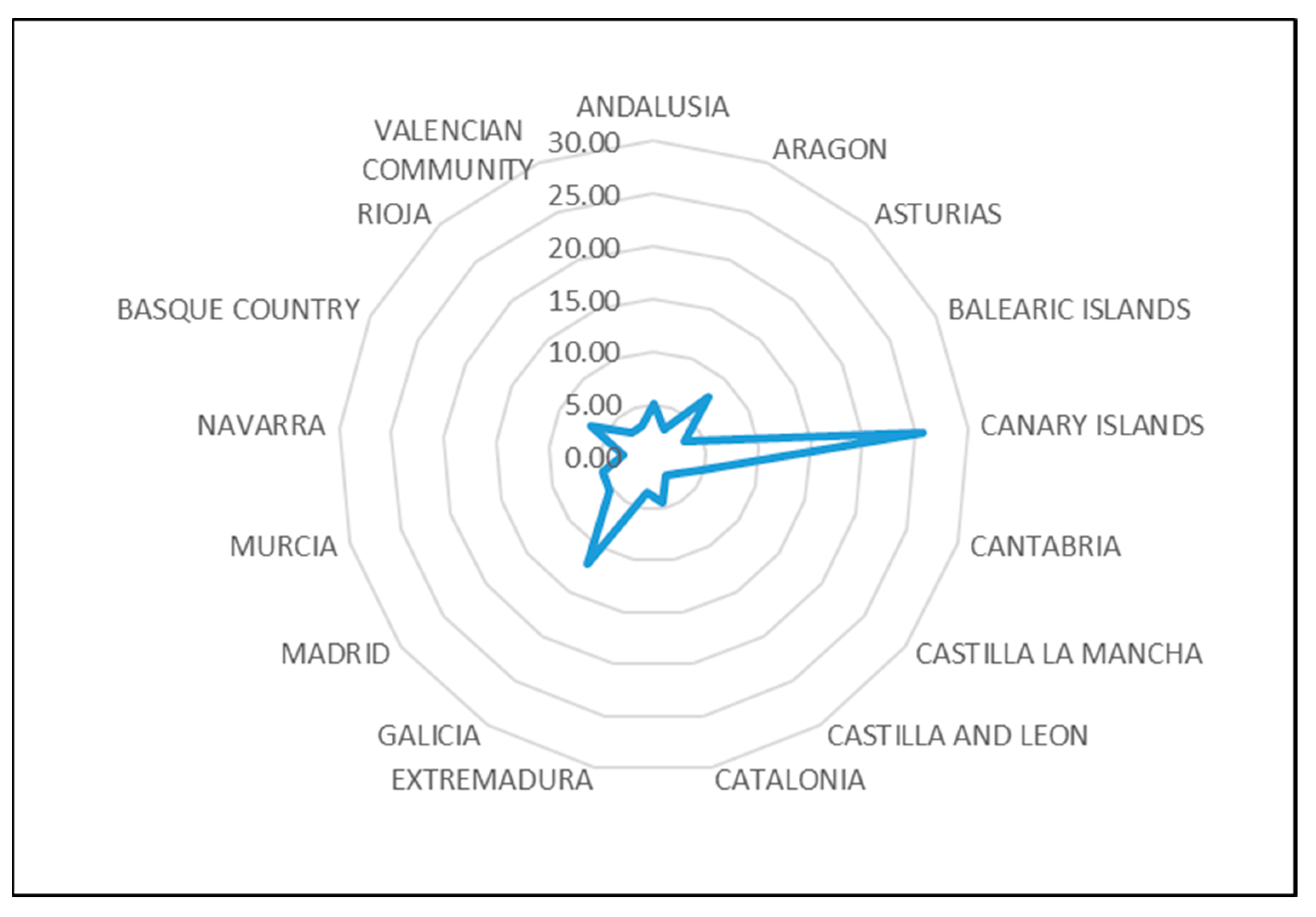
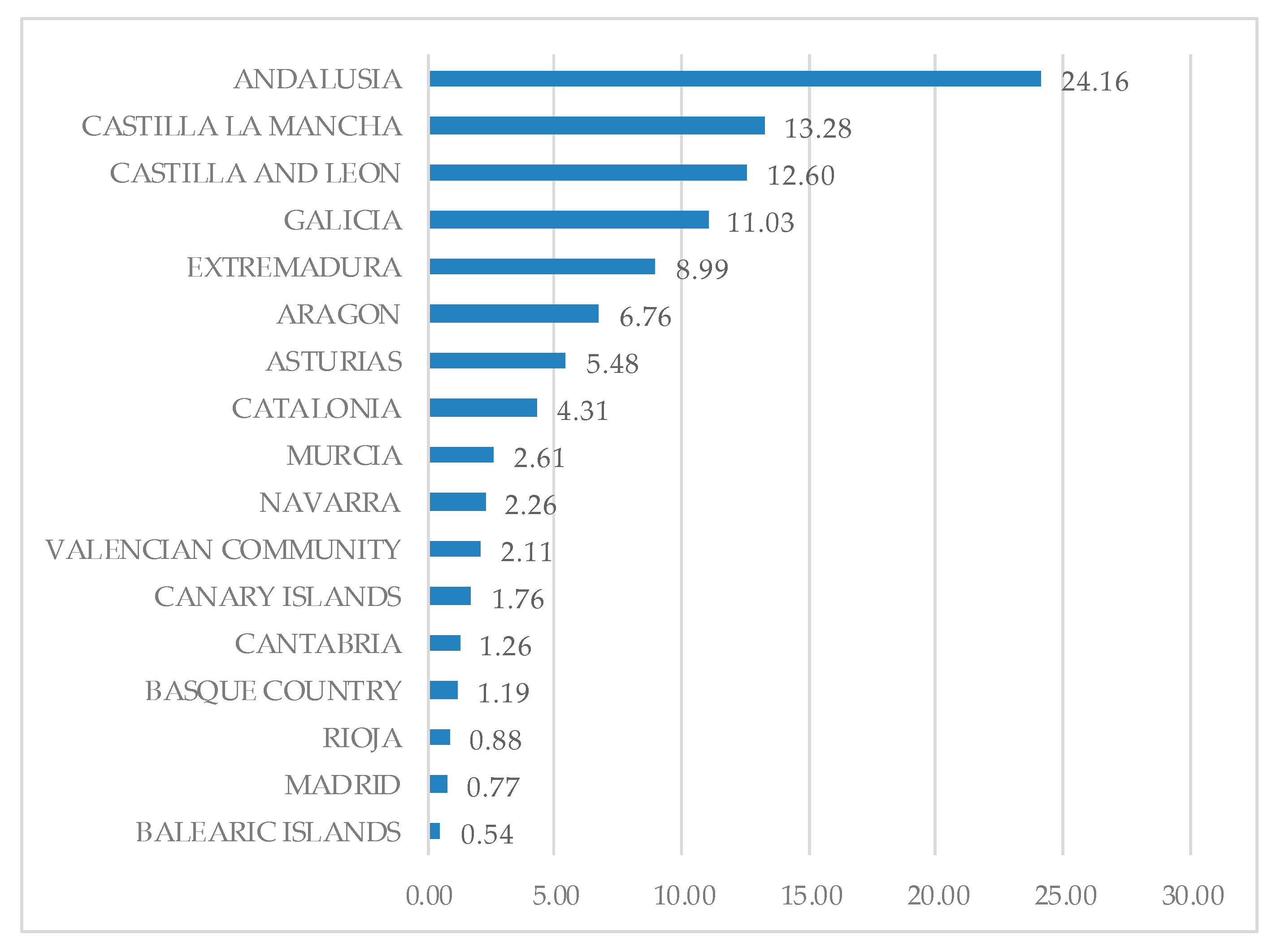
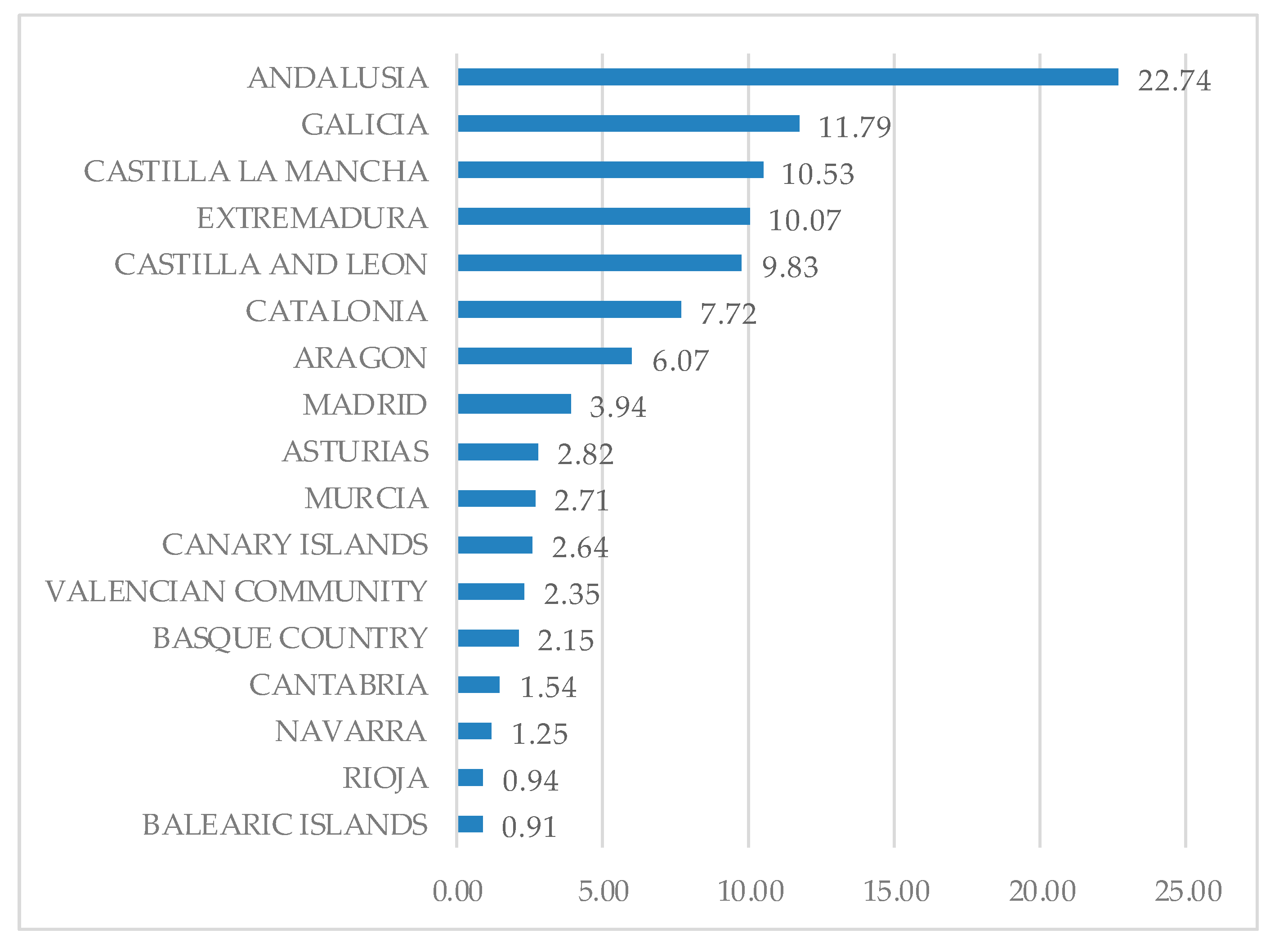
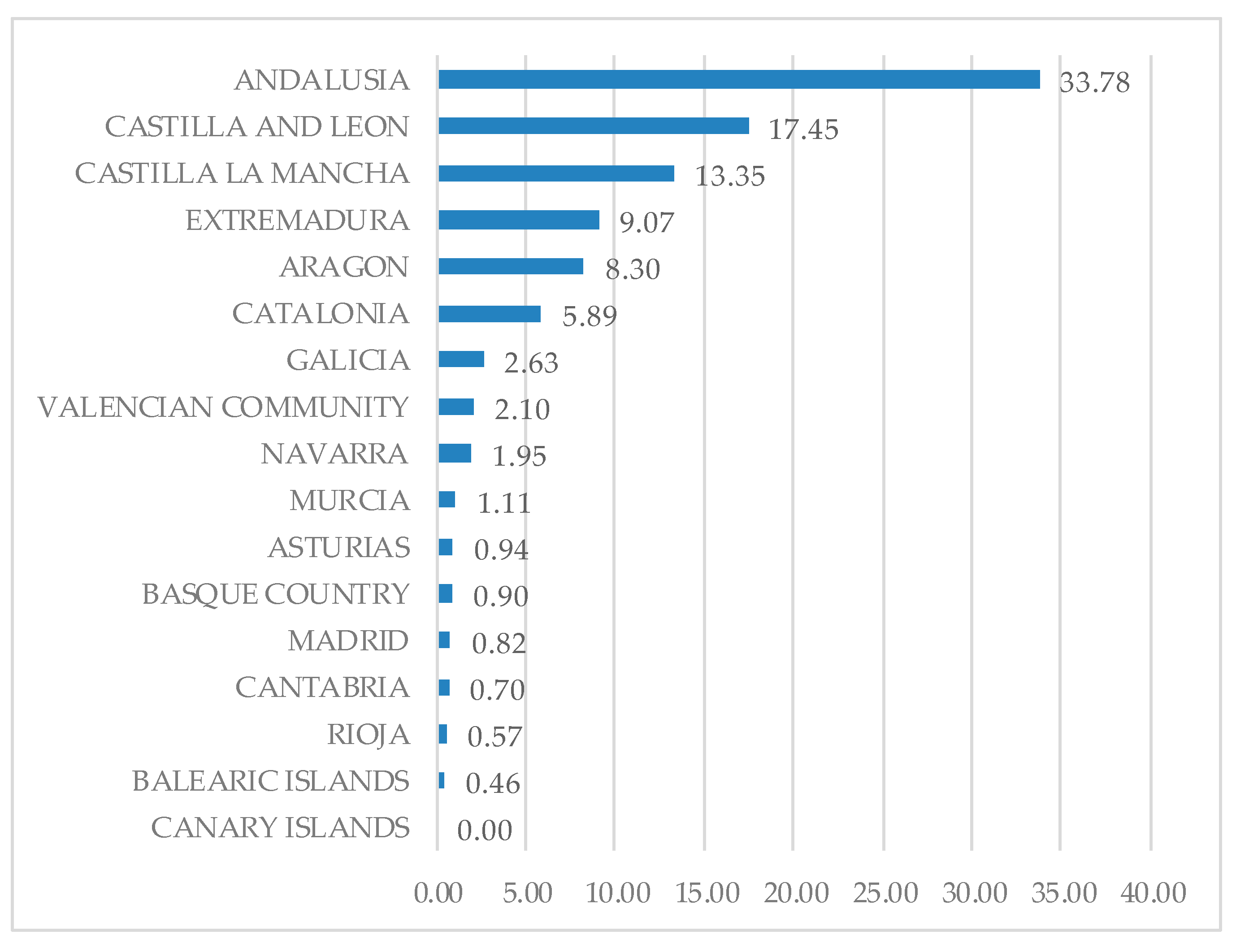
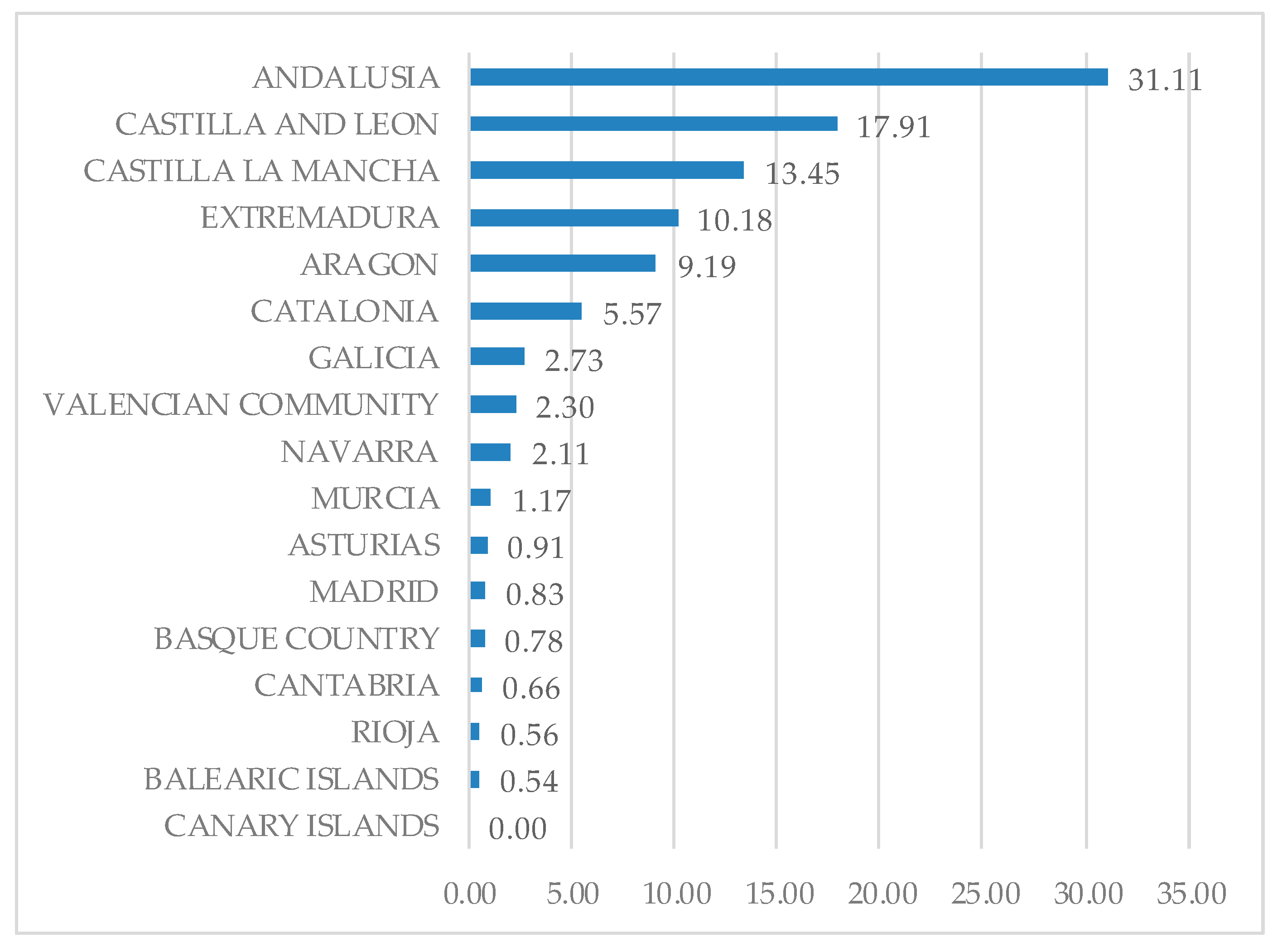
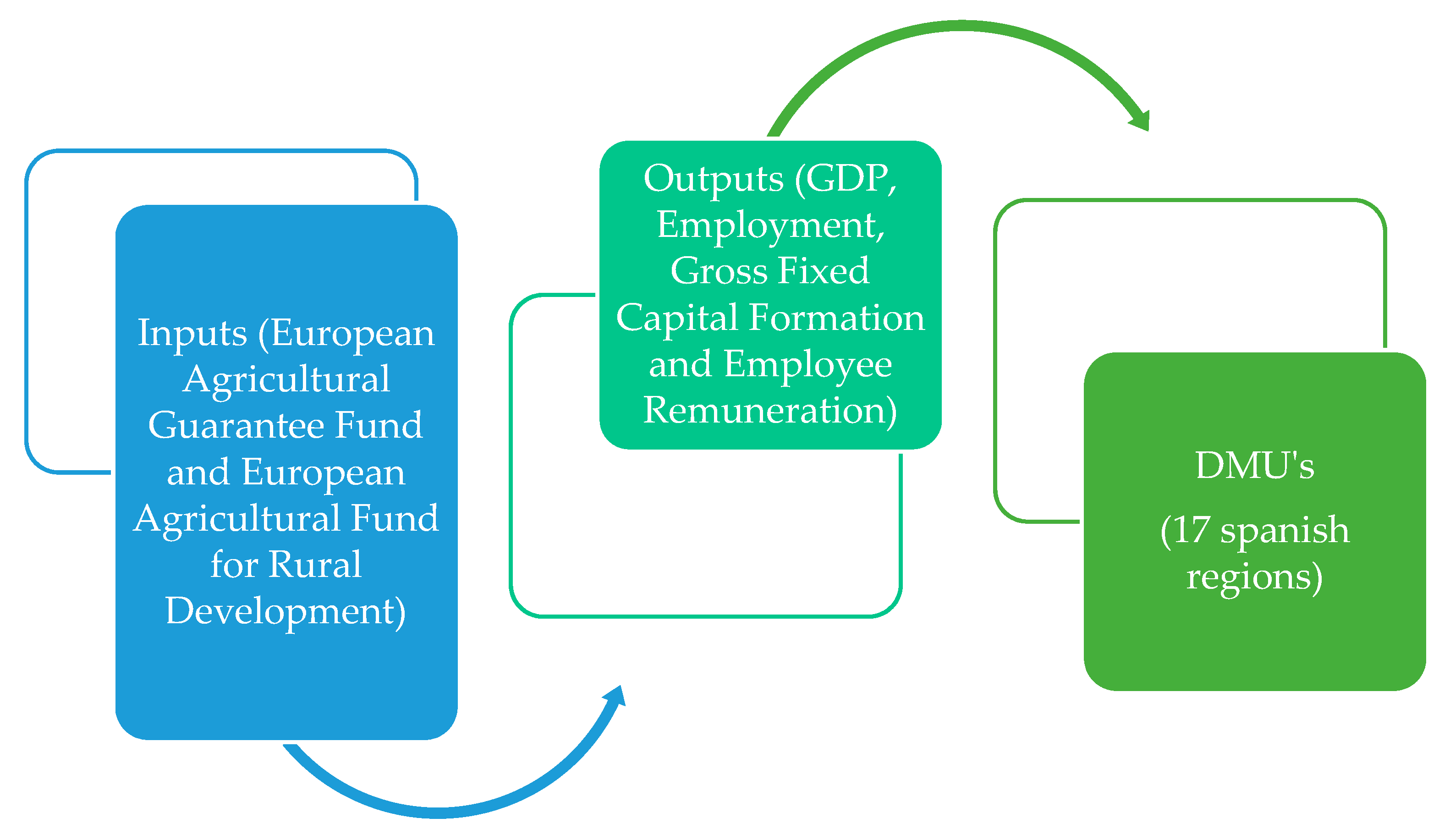
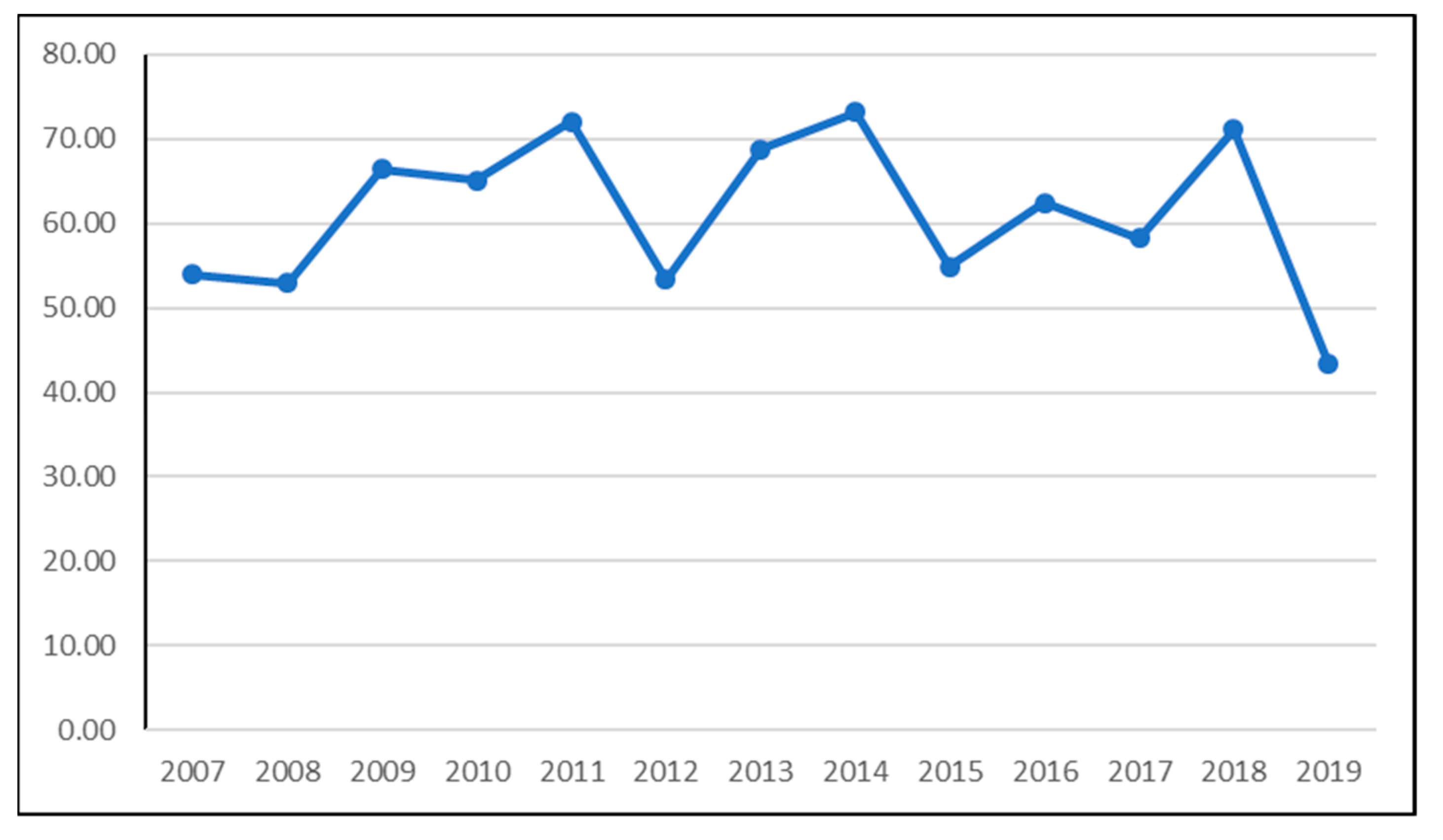
| EAFRD | EAGF | |||
|---|---|---|---|---|
| 2007–2013 | 2014–2019 | 2007–2013 | 2014–2019 | |
| ANDALUSIA | 1,152,232,636 | 1,019,670,477 | 9,654,187 | 1,316,063,405 |
| ARAGON | 322,474,820 | 272,145,901 | 2,371,820 | 388,613,223 |
| ASTURIAS | 261,094,682 | 126,472,228 | 268,800 | 38,385,231 |
| BALEARIC ISLANDS | 25,891,937 | 40,604,327 | 130,551 | 22,945,046 |
| CANARY ISLANDS | 83,826,028 | 118,171,711 | 0 | 0 |
| CANTABRIA | 60,240,311 | 69,101,404 | 200,061 | 28,077,314 |
| CASTILLA LA MANCHA | 633,146,804 | 472,011,313 | 3,815,654 | 569,248,532 |
| CASTILLA AND LEON | 600,863,526 | 440,863,820 | 4,988,589 | 757,798,249 |
| CATALONIA | 205,692,169 | 346,303,958 | 1,682,845 | 235,689,789 |
| EXTREMADURA | 428,840,620 | 451,725,588 | 2,591,770 | 430,539,688 |
| GALICIA | 525,796,704 | 528,762,573 | 751,164 | 115,706,304 |
| MADRID | 36,793,820 | 176,559,816 | 232,953 | 34,939,920 |
| MURCIA | 124,568,812 | 121,375,325 | 317,245 | 49,433,489 |
| NAVARRE | 107,937,680 | 56,150,828 | 556,716 | 89,396,872 |
| BASQUE COUNTRY | 56,541,728 | 96,281,045 | 256,945 | 32,922,788 |
| RIOJA | 41,733,287 | 42,010,323 | 162,287 | 23,850,492 |
| VALENCIAN COMMUNITY | 100,574,116 | 105,574,845 | 601,403 | 97,172,557 |
| Reference | Output Variables | Input Variables |
|---|---|---|
| Havlíček et al. [27] | Carcass meat production in sow/year/kg | Feed costs, other variable costs, labor costs, depreciation and finance costs |
| Gołaś et al. [28] | Value of the farm’s agricultural production | Utilised farm area in ha, number of work units, value of assets (capital without land value), value of indirect consumption, nitrogen surpluses in kg N per farm, phosphorus surpluses in kg P2O5 per farm |
| Fernández-Uclés et al. [29] | Turnover | Staff costs, expenditure on raw materials and other materials, Depreciation of property, plant and equipment |
| Bahta, Jordaan, and Sabastain [31] | Maize output per hectare | Nitrogen, phosphorus, potassium, and labor |
| Mengui, Oh, and Lee [26] | Potato quantity (bags of 100 kg) | Land size, seed quantity, potato labor used, capital, fertiliser, pesticides |
| Jalilov et al. [23] | Total yield of the main product (rice), yield of by-product (straw) | Seed and seedlings cost, land preparation cost, seedling transplanting cost, irrigation cost, fertiliser cost, weed control cost, pest control cost, crop harvest and carrying, threshing, winnowing and drying cost |
| Arru et al. [24] | Farming production, Recreational services | Land area, labor, capital, variable costs, provision of meals, accommodation |
| Sintori, Liontakis, and Tzouramani [25] | Milk per ewe, Lamb per ewe | Pastureland per productive ewe, labor per productive ewe, feedstuff per productive ewe, variable capital per productive ewe, ghg emissions per ewe |
| Niavis et al. [22] | Olive oil quantities produced from each farm, revenue achieved | Acreage in Ha of each farm, annual costs of energy, agrochemicals (fungicides and pesticides), fertilisers, and labor |
| Karimov [21] | Quantities of production both sold and kept for self-consumption | Land, labor, seeds, nitrogen fertiliser, diesel and other expenses |
| Type of Variable | Variable | Description | Explication |
|---|---|---|---|
| Product (output) | O1ij: GDP | GDP of the agricultural sector of the regions where i is the region and j is the year. | Collects the total production of crops generated in an economy during the calendar year. |
| O2ij: Employment | Total employment generated in the agricultural sector in the regions where i is the region and j is the year. | Collects the total employment generated in an economy in the agricultural sector. | |
| O3ij: Gross Fixed Capital Formation | Gross Fixed Capital Formation used in the agricultural sector where i is the region and j is the year. | Gross fixed capital formation is a macroeconomic concept that measures the value of fixed assets acquired or produced in a given period by both the public and private sectors. In this case, it reflects the valuation of the Gross Fixed Capital Formation (GFCF) of agricultural products, integrated by the GFCF of plantations and animals, and of non-agricultural products, integrated by the GFCF) of materials, machinery and transportation, buildings and others. | |
| O4ij: Employee Remuneration | Employee remuneration of the agricultural sector where i is the region and j is the year. | Refers to the gross income of the worker and the supplements received in kind valued in euros from the agricultural sector. | |
| Supplies (Inputs) | I1ij: EAGF | Annual investment of the region in EAGF, where i is the region and j is the year. | |
| I2ij: EAFRD | Annual investment of the region in EAFRD, where i is the region and j is the year. |
| Development Levels | Description | DMUs |
|---|---|---|
| Less developed regions | Regions whose gross domestic product (GDP) per capita is less than 75% of the average GDP of the EU-27. | Extremadura |
| Regions in transition | Regions whose GDP per capita is between 75% and 90% of the average GDP of the EU-27. | Castilla La Mancha Andalusia Murcia Canary Islands |
| More developed regions | Regions whose GDP per capita is above 90% of the average GDP of the EU-27. | Galicia Asturias Cantabria Basque Country Navarra Rioja Aragon Madrid Castilla and Leon Catalonia Valencian Community Balearic Islands |
| DMUs | 2007 | 2008 | 2009 | 2010 | 2011 | 2012 | 2013 | AVERAGE |
|---|---|---|---|---|---|---|---|---|
| ANDALUSIA | 100.00 | 100.00 | 100.00 | 100.00 | 100.00 | 100.00 | 100.00 | 100.00 |
| ARAGON | 39.10 | 35.63 | 49.95 | 67.20 | 72.12 | 72.77 | 81.87 | 59.81 |
| ASTURIAS | 20.59 | 11.78 | 14.47 | 19.38 | 15.45 | 15.96 | 23.74 | 17.34 |
| BALEARIC ISLANDS | 31.39 | 20.05 | 100.00 | 100.00 | 100.00 | 11.27 | 31.62 | 56.33 |
| VALENCIAN COMMUNITY | 78.93 | 100.00 | 100.00 | 100.00 | 100.00 | 100.00 | 100.00 | 96.99 |
| CANARY ISLANDS | 100.00 | 100.00 | 100.00 | 100.00 | 47.79 | 44.39 | 40.28 | 76.07 |
| CANTABRIA | 6.51 | 12.99 | 25.47 | 22.70 | 30.23 | 11.50 | 37.06 | 20.92 |
| CASTILLA AND LEON | 40.81 | 62.54 | 56.00 | 79.12 | 89.31 | 88.35 | 93.42 | 72.79 |
| CASTILLA LA MANCHA | 95.61 | 48.17 | 52.60 | 54.76 | 86.09 | 92.11 | 96.07 | 75.06 |
| CATALONIA | 42.91 | 68.34 | 92.55 | 89.00 | 100.00 | 84.33 | 88.73 | 80.84 |
| ESTREMADURA | 44.58 | 29.77 | 26.24 | 33.30 | 35.90 | 29.54 | 37.80 | 33.88 |
| GALICIA | 100.00 | 63.10 | 51.97 | 51.65 | 71.81 | 64.45 | 82.00 | 69.28 |
| RIOJA | 53.35 | 22.93 | 56.51 | 71.06 | 75.43 | 18.30 | 100.00 | 56.80 |
| MADRID | 23.85 | 68.19 | 68.18 | 26.74 | 58.58 | 23.13 | 86.68 | 50.76 |
| MURCIA | 100.00 | 100.00 | 100.00 | 100.00 | 100.00 | 100.00 | 100.00 | 100.00 |
| NAVARRE | 13.07 | 23.01 | 36.00 | 28.71 | 42.58 | 24.87 | 33.83 | 28.87 |
| BASQUE COUNTRY | 26.71 | 33.37 | 100.00 | 62.74 | 100.00 | 25.57 | 36.61 | 55.00 |
| SPANISH AVERAGE | 53.97 | 52.93 | 66.47 | 65.08 | 72.08 | 53.33 | 68.81 | 61.81 |
| DMUs | 2014 | 2015 | 2016 | 2017 | 2018 | 2019 | AVERAGE |
|---|---|---|---|---|---|---|---|
| ANDALUSIA | 100.00 | 100.00 | 100.00 | 100.00 | 100.00 | 100.00 | 100.00 |
| ARAGON | 73.99 | 38.04 | 79.31 | 56.63 | 59.53 | 43.66 | 58.53 |
| ASTURIAS | 32.38 | 6.94 | 22.58 | 18.45 | 29.77 | 15.79 | 20.99 |
| BALEARIC ISLANDS | 52.35 | 12.01 | 10.90 | 19.64 | 38.18 | 10.47 | 23.93 |
| VALENCIAN COMMUNITY | 100.00 | 41.55 | 100.00 | 100.00 | 100.00 | 74.82 | 86.06 |
| CANARY ISLANDS | 44.97 | 100.00 | 32.65 | 67.52 | 100.00 | 26.91 | 62.01 |
| CANTABRIA | 32.91 | 4.40 | 17.32 | 13.32 | 48.30 | 9.27 | 20.92 |
| CASTILLA AND LEON | 100.00 | 52.52 | 87.76 | 62.13 | 60.83 | 57.54 | 70.13 |
| CASTILLA LA MANCHA | 73.30 | 100.00 | 100.00 | 100.00 | 100.00 | 100.00 | 95.55 |
| CATALONIA | 85.10 | 57.41 | 97.28 | 68.35 | 77.32 | 38.93 | 70.73 |
| ESTREMADURA | 29.96 | 46.66 | 47.49 | 55.83 | 54.69 | 49.33 | 47.33 |
| GALICIA | 72.38 | 100.00 | 67.94 | 41.22 | 97.77 | 48.87 | 71.36 |
| RIOJA | 71.67 | 32.13 | 100.00 | 32.12 | 81.91 | 19.06 | 56.15 |
| MADRID | 100.00 | 13.01 | 8.29 | 100.00 | 65.91 | 6.24 | 48.91 |
| MURCIA | 100.00 | 100.00 | 100.00 | 100.00 | 100.00 | 100.00 | 100.00 |
| NAVARRE | 100.00 | 100.00 | 68.71 | 33.80 | 32.41 | 20.38 | 59.22 |
| BASQUE COUNTRY | 74.38 | 28.07 | 21.85 | 22.12 | 63.38 | 15.97 | 37.63 |
| SPANISH AVERAGE | 73.14 | 54.87 | 62.48 | 58.30 | 71.18 | 43.37 | 60.55 |
| DMUs | AVERAGE | N. OF TIMES OF MAXIMUM EFFICIENCY | MAXIMUM EFFICIENCY | MINIMUM EFFICIENCY | VARIATION |
|---|---|---|---|---|---|
| ANDALUSIA | 100.00 | 7 | 100.00 | 100.00 | 0.00 |
| ARAGON | 59.81 | 0 | 81.87 | 35.63 | 46.24 |
| ASTURIAS | 17.34 | 0 | 23.74 | 11.78 | 11.96 |
| BALEARIC ISLANDS | 56.33 | 3 | 100.00 | 11.27 | 88.73 |
| VALENCIAN COMMUNITY | 96.99 | 6 | 100.00 | 78.93 | 21.07 |
| CANARY ISLANDS | 76.07 | 4 | 100.00 | 40.28 | 59.72 |
| CANTABRIA | 20.92 | 0 | 37.06 | 6.51 | 30.55 |
| CASTILLA AND LEON | 72.79 | 0 | 93.42 | 40.81 | 52.61 |
| CASTILLA LA MANCHA | 75.06 | 0 | 96.07 | 48.17 | 47.90 |
| CATALONIA | 80.84 | 1 | 100.00 | 42.91 | 57.09 |
| ESTREMADURA | 33.88 | 0 | 44.58 | 26.24 | 18.34 |
| GALICIA | 69.28 | 1 | 100.00 | 51.65 | 48.35 |
| RIOJA | 56.80 | 1 | 100.00 | 18.30 | 81.70 |
| MADRID | 50.76 | 0 | 86.68 | 23.13 | 63.55 |
| MURCIA | 100.00 | 7 | 100.00 | 100.00 | 0.00 |
| NAVARRE | 28.87 | 0 | 42.58 | 13.07 | 29.51 |
| BASQUE COUNTRY | 55.00 | 2 | 100.00 | 25.57 | 74.43 |
| SPANISH AVERAGE | 61.81 | 0 | 72.08 | 52.93 | 19.14 |
| DMUs | AVERAGE | N. OF TIMES OF MAXIMUM EFFICIENCY | MAXIMUM EFFICIENCY | MINIMUM EFFICIENCY | VARIATION |
|---|---|---|---|---|---|
| ANDALUSIA | 100.00 | 6 | 100.00 | 100.00 | 0.00 |
| ARAGON | 53.91 | 0 | 79.31 | 38.04 | 41.27 |
| ASTURIAS | 22.18 | 0 | 32.38 | 6.94 | 25.44 |
| BALEARIC ISLANDS | 24.19 | 0 | 52.35 | 10.47 | 41.88 |
| VALENCIAN COMMUNITY | 86.96 | 4 | 100.00 | 41.55 | 58.45 |
| CANARY ISLANDS | 62.97 | 2 | 100.00 | 26.91 | 73.09 |
| CANTABRIA | 26.16 | 0 | 48.30 | 4.40 | 43.90 |
| CASTILLA AND LEON | 62.83 | 1 | 100.00 | 52.52 | 47.48 |
| CASTILLA LA MANCHA | 98.52 | 5 | 100.00 | 73.30 | 26.70 |
| CATALONIA | 62.33 | 0 | 97.28 | 38.93 | 58.35 |
| ESTREMADURA | 50.45 | 0 | 55.83 | 29.96 | 25.87 |
| GALICIA | 72.67 | 1 | 100.00 | 41.22 | 58.78 |
| RIOJA | 52.37 | 1 | 100.00 | 19.06 | 80.94 |
| MADRID | 40.35 | 2 | 100.00 | 6.24 | 93.76 |
| MURCIA | 100.00 | 6 | 100.00 | 100.00 | 0.00 |
| NAVARRE | 37.34 | 2 | 100.00 | 20.38 | 79.62 |
| BASQUE COUNTRY | 38.99 | 0 | 74.38 | 15.97 | 58.41 |
| SPANISH AVERAGE | 58.37 | 0 | 73.14 | 43.37 | 29.77 |
Publisher’s Note: MDPI stays neutral with regard to jurisdictional claims in published maps and institutional affiliations. |
© 2021 by the authors. Licensee MDPI, Basel, Switzerland. This article is an open access article distributed under the terms and conditions of the Creative Commons Attribution (CC BY) license (https://creativecommons.org/licenses/by/4.0/).
Share and Cite
Blanco, M.; Ferasso, M.; Bares, L. The Regional Efficiency in the Use of European Agricultural Funds in Spain: Growth and Employment Analyses. Agronomy 2021, 11, 1109. https://doi.org/10.3390/agronomy11061109
Blanco M, Ferasso M, Bares L. The Regional Efficiency in the Use of European Agricultural Funds in Spain: Growth and Employment Analyses. Agronomy. 2021; 11(6):1109. https://doi.org/10.3390/agronomy11061109
Chicago/Turabian StyleBlanco, Miguel, Marcos Ferasso, and Lydia Bares. 2021. "The Regional Efficiency in the Use of European Agricultural Funds in Spain: Growth and Employment Analyses" Agronomy 11, no. 6: 1109. https://doi.org/10.3390/agronomy11061109
APA StyleBlanco, M., Ferasso, M., & Bares, L. (2021). The Regional Efficiency in the Use of European Agricultural Funds in Spain: Growth and Employment Analyses. Agronomy, 11(6), 1109. https://doi.org/10.3390/agronomy11061109







